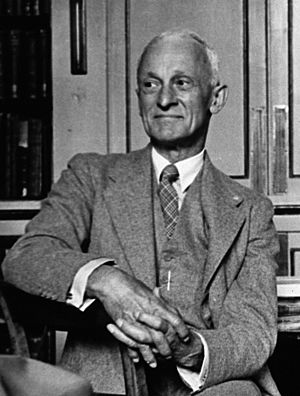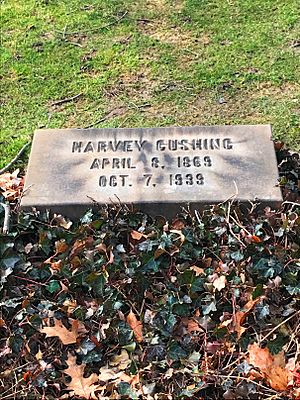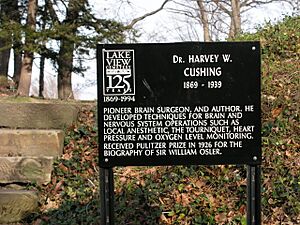Harvey Cushing facts for kids
Quick facts for kids
Harvey Cushing
|
|
|---|---|

Harvey Cushing in 1938
|
|
| Born |
Harvey Williams Cushing
April 8, 1869 Cleveland, Ohio, U.S.
|
| Died | October 7, 1939 (aged 70) New Haven, Connecticut, U.S.
|
| Education | Yale University Harvard Medical School Massachusetts General Hospital (internship) Johns Hopkins Hospital |
| Years active | 1895–1935 |
| Known for |
|
| Medical career | |
| Profession |
|
| Institutions | Private practice (Baltimore) Johns Hopkins Hospital (Associate Professor of Surgery, c. 1891) Peter Bent Brigham Hospital and (surgeon-in-chief) Harvard Medical Yale School of Medicine (Sterling Professor of Medicine in Neurology, 1933-1937) |
| Awards | Fellow of American Academy of Arts and Sciences Cameron Prize for Therapeutics of the University of Edinburgh (1924) Pulitzer Prize (1926) Lister Medal (1930) |
Harvey Williams Cushing (born April 8, 1869 – died October 7, 1939) was an American doctor. He was a neurosurgeon, which means he specialized in brain and nervous system surgery. He was also a writer and artist. Dr. Cushing was a pioneer in brain surgery. He was the first doctor to focus only on neurosurgery. He also described a medical condition called Cushing's disease.
Contents
Early Life and Education
Harvey Cushing was born in Cleveland, Ohio. He was the youngest of ten children. His father, Henry Kirke Cushing, was also a doctor.
How Did Harvey Cushing Get Interested in Medicine?
As a child, Cushing went to the Cleveland Manual Training School. This school helped him become very interested in science and medicine. The school taught him to experiment and use a "physics-focused" way of thinking. This helped him choose a career in surgery. The school also taught him to be very good with his hands, which is important for a surgeon.
Where Did Harvey Cushing Study?
Cushing graduated from Yale University in 1891. He then studied medicine at Harvard Medical School and became a doctor in 1895. He completed his training at Massachusetts General Hospital. After that, he worked with a famous surgeon named William Stewart Halsted at Johns Hopkins Hospital in Baltimore. He also trained in Europe with other important neurosurgeons.
Medical Career and Discoveries
Dr. Cushing started his medical career in Baltimore. While studying in Europe, he learned about the Cushing reflex. This reflex explains how blood pressure and pressure inside the brain are connected.
At age 32, he became a professor of surgery at Johns Hopkins Hospital. He was put in charge of all surgeries involving the central nervous system. He wrote many books about brain and spinal column surgery. He also made important discoveries in bacteriology, the study of bacteria.
He helped figure out which parts of the brain control different body functions. He also developed a way to do surgery using only local anaesthesia. This means numbing just the area being operated on. In 1911, he became the chief surgeon at Peter Bent Brigham Hospital in Boston. He also became a professor at Harvard Medical School in 1912.
Harvey Cushing and World War I
When the United States joined World War I, Cushing became a major in the U.S. Army Medical Corps in 1917. He led a U.S. hospital unit in France. He also worked at a French military hospital near Paris.
During the war, Cushing found a way to use electromagnets. He used them to remove metal shrapnel pieces from soldiers' brains. He was praised for his work by military leaders. He was promoted to lieutenant colonel and then to colonel. He treated many wounded soldiers, including the son of his mentor, Sir William Osler.
Cushing returned to the U.S. in 1919. He received awards for his service, including the Distinguished Service Medal.
Later Career and Legacy
After the war, Cushing wrote a biography about Sir William Osler. This book won the Pulitzer Prize in 1926. From 1933 to 1937, he worked at the Yale School of Medicine. He was a professor of neurology there until he retired.
Harvey Cushing passed away on October 7, 1939, in New Haven, Connecticut. He died from heart problems. Doctors found a colloid cyst in his brain during an autopsy.
What Were Harvey Cushing's Biggest Contributions?
Cushing created many basic surgical methods for brain operations. This made him a top expert in his field. Because of him, neurosurgery became its own special type of surgery.
- He greatly improved how well patients survived after difficult brain surgeries for tumors.
- He used X-rays to help find brain tumors.
- He used electrical signals to study the human brain's sensory areas.
- He helped develop the Bovie electrocautery tool with physicist William T. Bovie. This tool uses heat to cut tissue and stop bleeding.
- He taught many neurosurgeons in the early 1900s.
One of Cushing's most important contributions was bringing blood pressure measurement to North America. He visited an Italian doctor, Scipione Riva-Rocci, who had a simple way to measure blood pressure. Riva-Rocci had invented a device in 1896. It used a cuff that inflated to measure the pressure needed to stop blood flow.
Cushing brought this device, called a sphygmomanometer, back to the U.S. Soon, measuring blood pressure became a standard part of checking a patient's health. This device was used widely until 1905. That's when Russian doctor Nikolai Korotkov improved it. He added a way to measure diastolic blood pressure, which is the pressure when the heart rests.

Cushing is also famous for discovering Cushing's disease. In 1912, he described a condition caused by a problem with the pituitary gland. He published his findings in 1932.
Cushing received many honors for his work. He was elected to important scientific groups like the American Academy of Arts and Sciences and the National Academy of Sciences. He also won the Lister Medal in 1930 for his contributions to surgery. He was considered for the Nobel Prize in Physiology or Medicine many times.
Several things have been named after him:
- The World War II ship SS Harvey Cushing.
- Cushing General Hospital in Framingham, Massachusetts.
- A 45-cent postage stamp issued by the United States Postal Service in 1988.
Cushing also invented many surgical tools still used today. These include Cushing forceps and the Cushing ventricular cannula. Forceps are used to hold tissues during surgery. The cannula helps drain fluid from the brain. He also created a surgical magnet to remove shrapnel during World War I.
The Harvey Cushing/John Hay Whitney Medical Library at Yale University has many medical books and historical items. It also has a collection of Cushing's brain specimens.
Personal Life
Harvey Cushing married Katharine Stone Crowell in 1902. They had five children. Three of their daughters were known for their beauty and were called the 'Cushing sisters'.
- William Harvey Cushing (1903–1926)
- Mary Benedict "Minnie" Cushing (1906–1978)
- Betsey Cushing (1908–1998)
- Henry Kirke Cushing (1910–1983)
- Barbara "Babe" Cushing (1915–1978)
Doctors Who Trained Under Cushing
Many important doctors learned from Harvey Cushing. Some of them include:
- Walter Dandy, who was the first pediatric neurosurgeon.
- Leo M. Davidoff, who started the Department of Neurological Surgery at the Albert Einstein College of Medicine.
- Wilder Penfield, a pioneer neurosurgeon who founded the Montreal Neurological Institute.
|
See also
 In Spanish: Harvey Cushing para niños
In Spanish: Harvey Cushing para niños
- History of medicine
- Timeline of medicine and medical technology




